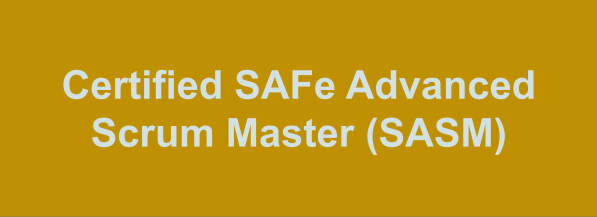As a practicing scrum master in a SAFe organization, you have the tactical skills to coach Agile teams to deliver business value. Build on that solid foundation in the SAFe Advanced Scrum Master course and discover how to facilitate success for Agile teams, Agile Release Trains (ARTs), and the organization. And get the guidance and tools you need to work effectively in remote environments with distributed teams.
SASM: Certified SAFe Advanced Scrum Master
SAFe SASM Exam Summary:
| Exam Name | SAFe Advanced Scrum Master |
| Exam Code | SASM |
| Exam Fee | First attempt included in the course registration fee if taken within 30 days of course completion. Each retake or attempt past the 30-day window is $50. |
| Exam Duration | 120 Minutes |
| Number of Questions | 60 |
| Passing Score | 44/60 (73%) |
| Format | Multiple choice (one answer) or multiple select (2-3 answers) |
| Books / Trainings | SAFe Advanced Scrum Master SAFe Training Class Books |
| Sample Questions | SAFe Advanced Scrum Master Exam Sample Questions and Answers |
| Practice Exam | Certified SAFe Advanced Scrum Master (SASM) Practice Test |
SAFe Advanced Scrum Master Syllabus Topics:
| Topic | Details | Weights |
| Exploring the Scrum Master role | - Explore Scrum Master challenges in the Enterprise - Explain the purpose and basic constructs of SAFe - Establish Scrum Master connections in SAFe |
15% |
| Applying SAFe Principles | - #1 - Take an economic view - #2 - Apply systems thinking - #3 - Assume variability; preserve options - #4 - Build incrementally with fast, integrated learning cycles - #5 - Base milestones on objective evaluation of working systems - #6 - Visualize and limit WIP, reduce batch sizes, and manage queue lengths - #7 - Apply cadence, synchronize with cross-domain planning - #8 - Unlock the intrinsic motivation of knowledge workers - #9 - Decentralize decision-making |
15% |
| Exploring Agile and Scrum anti-patterns | - Explore anti-patterns associated with the Product Owner role - Explain how Stories and tasks may lead to anti-patterns - Identify context-specific anti-patterns in your environment |
13% |
| Facilitating program execution | - Synchronize development with the Agile Release Train - Organize teams on the Train - Plan the Program Increment - Execute the Program Increment - Release value on demand - Prepare for the next PI Planning session |
15% |
| Improving flow with Kanban and XP | - Build your Kanban board - Measure and optimize flow - Build quality in - Foster engineering craftsmanship - Facilitate collaboration with Architects, System Team, and Operations |
13% |
| Building high-performing teams | - Foster collaboration on the team - Facilitate cross-team collaboration - Build trust with stakeholders - Develop team skill set - Create an Improvement Backlog |
17% |
| Improving program performance | - Explore the Inspect and Adapt process - Apply problem-solving workshop |
12% |





0 comments:
Post a Comment